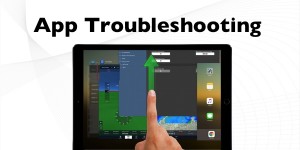
Everyone knows how to open an app on the iPad–just tap the icon and it’s off to the races. This is one of the things pilots love about the iPad. But what about closing apps–do you know the difference between sleeping an app, shutting down an app and deleting an app? It’s an important distinction that comes into play when an app starts misbehaving.
How to close an app
Say you’re planning a flight on your iPad, and you open up ForeFlight. When you’re finished with the app, you’ll most likely press the round button at the bottom of the iPad. This takes you back to the home screen and you can open another app. Did you close ForeFlight? Sort of. What you’ve actually done is put the app in sleep mode. The app is paused, and no longer running, but it’s not fully shut down. You can open the app back up and you’ll pick up right where you left off. It’s great for switching back and forth between apps.
To completely close out an app, double tap the home button to bring up preview windows of apps you’ve recently had open. This shows your most recently used apps, and you can swipe from right to left to view additional apps. To reopen one of these simply tap the preview window. If you want to completely close the app, swipe the preview window towards the top and then off the screen. You can do this to some or all of the apps in your lineup of recently used apps.
Why would you want to do this? If the app you’re using is acting strangely or you think you might have a bug, closing the app completely and restarting it can sometimes fix the problem. For example, we recently used a weather radar app numerous times in the same day. After multiple uses, the app had trouble updating the radar picture–it just seemed stuck. Closing the app and restarting it fixed the problem. Some iPad users swear that shutting down unused apps helps battery life, but our battery tests show otherwise.
Deleting an app
Note that shutting down an app is not the same as deleting it. When you shut down an app (as shown above), it is still installed and fully functional. To completely erase an app from your iPad, tap and hold the icon on the main home screen. You’ll see the icons wiggle and a black X at the top left. Tapping this will bring up a confirmation box, then allow you to delete the app.
Sometimes this is the only way to fix a serious app problem, by deleting it from your iPad and downloading it again from the App Store. You won’t have to pay again: when you go to the App Store, the icon for all purchased apps has a cloud download symbol so you can just tap to redownload.
There’s one other way to delete an app, one that can come in handy if your iPad is acting strangely. We’ve seen instances where tapping and holding an app icon to delete it won’t work – the app stubbornly stays on your home screen. In this case, you can go to the Settings app –> General –> Storage & iCloud Usage –> Manage Storage. From here, you can see which apps are taking up the most storage space. You can also tap on an app to delete it, bypassing the home screen method.
Restarting your iPad
If your iPad just isn’t working properly or an app seems to be hanging up, the old advice to reboot and try again is worth trying. Just like with apps, there’s a difference between sleeping your iPad and turning off your iPad. If you tap the power button at the top right corner of your iPad, the screen turns off, but the iPad stays on. This is fine for everyday use, and saves a lot of battery. But to completely shut down the iPad, you need to hold down the power button, then swipe the red button that appears on the screen.
Here again, that normal procedure doesn’t always work. If you iPad is completely frozen and even the power button doesn’t work, there is one more trick. You can press and hold the power and home buttons at the same time. After about 5 seconds, the iPad will restart. Keep this in your back of tricks for those rare times when your iPad just won’t cooperate.
Source: Ipad appsApp troubleshooting: how to close, delete and restart



